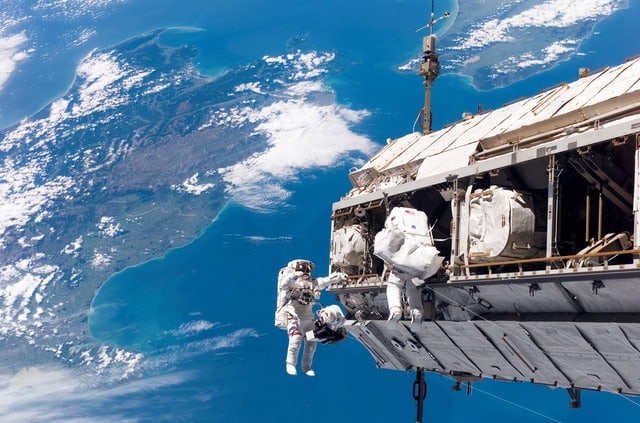A bacteria have survived for years outside the ISS, supporting the hypothesis that life came to Earth from space.
In a new study, researchers explain that bacteria exposed outside the International Space Station (ISS) survived the extreme conditions of space for more than three years. This is a back to the panspermia, the hypothesis that life on Earth could have originated from the arrival on the planet of germs present throughout the Universe.
“The origin of life on Earth is the biggest mystery of human beings. Scientists can have totally different points of view on the matter. Some think that life is very rare and happened only once in the Universe, while others think that life can happen on every suitable planet. If panspermia is possible, life must exist much more often than we previously thought,” said Akihiko Yamagishi, professor at the Tokyo University of Pharmacy and Life Sciences, and principal investigator for the Tanpopo mission, the Japanese term for dandelion flower or dandelion.
Life, “more common than we thought”
“Scientists can have totally different points of view on the matter. Some think that life is very rare and happened only once in the Universe, while others think that life can happen on every suitable planet,” Yamagishi assured. “If panspermia is possible, life must exist much more often than we previously thought,” he added.
The idea is that everywhere in the Universe, scattered like dandelion plumes, you find microbes that develop when they encounter favourable circumstances to do so.
The experiment led by Yamagishi in 2018 tested the presence of microbes in the atmosphere using an aircraft and scientific balloons that found Deinococcal bacteria floating at 12,000 meters above sea level.
Resistant bacteria
These bacteria are known to form colonies that can reach a length of more than one millimeter and are resistant to ultraviolet radiation and other environmental factors, and scientists then wondered if they could hold out in outer space long enough to travel interplanetary distances.
In search of an answer, the Japanese team placed clumps of dried Deinococcus on exposed panels outside the ISS. The samples, of different thickness, were left there for one, two and three years before observing their survival.
Previous experiments had shown that bacteria could survive for long periods in space if they were shielded by rock formations, but this was the first study into the possibility of bacteria surviving in outer space in the form of clumps or clusters.
A protective layer
Three years later, the researchers found that clusters more than 0.5 millimeters thick had partially survived space conditions, and noted that while the bacteria on the surface had dried, a protective layer had been created that ensured the colony’s survival.
The researchers then used the survival data at one, two, and three years of exposure and calculated that a cluster more than 0.5 millimeters thick would survive for 15 to 45 years outside the ISS laboratory. By extrapolating this information, scientists have calculated that a one-millimeter-thick colony could survive for up to eight years in the extreme conditions of outer space.
From Earth to Mars
“The results suggest that radioresistant Deinococcus could survive during the travel from Earth to Mars and vice versa, which is several months or years in the shortest orbit”, Yamagishi said.
The notions that support the hypothesis of panspermia have their roots in some considerations of the Greek philosopher Anaxagoras (500-428 BC), and the term was substantiated by the German biologist Hermann Richter in 1865.
In 1908, the Swedish chemist Svante August Arrhenius used the word panspermia to explain the appearance of life on Earth and the hypothesis was supported by the British astronomer Fred Hoyle (1915-2001).
Original Research Article
